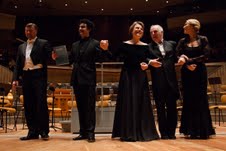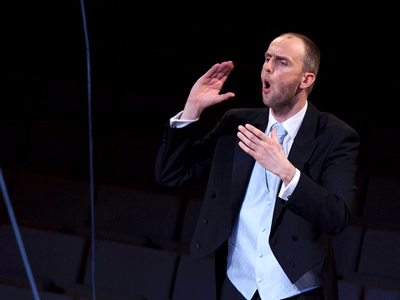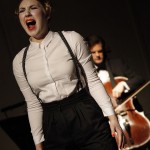By: Edna Landau
To ask a question, please write Ask Edna.
Dear Edna:
First, thanks for your blog. I recommend it to folks all the time! And here’s my latest question: I was wondering if you could give us your perspective on what makes an effective musician’s publicity video – for both soloists and ensembles? I’ve been seeing such a variety of approaches, lengths and production values, it makes me wonder what you’re recommending these days. Thanks.
Angela Beeching, Longtime Edna fan and author, “Beyond Talent”
Dear Angela:
It is always a pleasure and an honor to hear from you. Thanks for the compliment on my blog. You bring up a very interesting topic, because there is no clear definition of what a typical publicity video might be. Many artists don’t have them at all. They choose to upload performances onto YouTube, or include them on their website as part of a media page, and that satisfies most of the presenters who are primarily interested in how they play, sing, or conduct in a variety of repertoire. If they have good videos of themselves engaging in outreach activities, those will often be posted as well. Finally, if they have clearance to post interview footage, they will include it in the mix. The latter gives a better indication of what they are like as communicators in a non-performing situation and acquaint the viewer with other aspects of their life that are important to them. It is still pretty uncommon for artists and ensembles to hire people to create a promotional video for them, partly because of the cost. It is far more common for artists who have recording affiliations to have videos that relate to a particular recording project, which are produced by the record company. Such videos might make you want to run out and buy the album, but you may not learn too much about the artist.
An ideal promotional video, in my opinion, will feature the artist speaking and performing, and may be embellished by some background footage and a narrative that weaves everything together. It will be joyful and energetic, or insightful and moving in a way that compels you to watch until the very end. It will give a good idea of what makes the artist tick and reflect the passion and commitment that fuel their artistry. A length of three to seven minutes seems to work well. Some artists who may not have had the means to hire someone to produce a video from scratch have obtained the rights to video footage from interviews and edited it down, primarily showing them talking, but not the interviewer. The more successful ones include performance samples or the artist playing in the background. I found two that I particularly liked, which are both of violinists: Vilde Frang and Madalyn Parnas. Ms. Frang’s video was posted by her general management, Askonas Holt, who call it a “video biography”. It features the young violinist rehearsing the Bruch Concerto No. 1 with the Philharmonia Orchestra and Jakob Hrusa, interspersed with comments by Ms. Frang, seemingly excerpted from an interview, which include reflections about the importance of being inspired and the broad variety of potential sources for inspiration, all articulated in a soft but compelling way that draws the viewer in. Ms. Frang’s apparent wisdom beyond her years, and her beautiful playing, convinced me over the course of the seven minute video that I must be sure not to miss her next appearance in New York. I was introduced to violinist Madalyn Parnas by Portrait of a Violinist: Madalyn Parnas, which was created by Steve Torres, a friend who she met at Indiana University. He loved the idea of tagging along with her on the day of a concert in New York and decided to interview her and make the video as an independent project. This video has some background playing by Ms. Parnas and some attractive glimpses of New York City, but very little actual performance footage. Still, one is captivated by Ms. Parnas as a person, right from the start of the video when she says: “From the very beginning I was passionate about music.” Her passion is palpable, as are her charm and energy. The video ends with her saying: “What a blessing to be able to make music your profession.” In between, she speaks about the joy of working with living composers and her new recording with her sister and duo partner, Cicely, with whom she is briefly viewed in a new music performance. Madalyn comes across as genuine, modest, and extraordinarily dedicated to her craft. The bits of playing in the background reinforce the impression of a serious artist but in this video, it is the sheer force of personality that captivates the viewer.
In general, there seem to be more ensemble promotional videos than soloist ones. The majority of ensemble videos I have viewed seem to have been produced in an effort to clarify the mission and vision of groups whose names and instrumentation alone might not give a clear enough idea of their identity. One such ensemble is Time for Three, whose promotional video, only three minutes long, is chock full of energy and dynamism. It starts with them entering the stage with Christoph Eschenbach at a Philadelphia Orchestra concert and ends with a whopping quote from Sir Simon Rattle. (Other impressive quotes are also intermittently flashed on the screen.) In between, they are seen talking, performing and interacting with one another, always exuding a sense of fun. I encourage you to watch it since no description really does it justice. Classical Jam, a hard to define chamber group whose core musicians perform on violin, viola, cello, flute and percussion, regularly collaborate with other top-notch musicians in a variety of concert formats, in which they work closely with presenters towards the important goals of community building and arts advocacy. They recently produced a video to demonstrate an interactive feature of some of their concerts, which they call the Master Jam. It begins with an explanation of who they are, and has many well-chosen images which relate to these goals and clearly demonstrate the wonderful impact that the ensemble has on its audiences. Their energy and joy are abundantly evident from the start. The background music which runs throughout the three minute video is very appealing and it ends with Classical Jam’s mission and vision statement. The group’s cellist, Wendy Law, told me that they worked with a filmmaker, Natasha Marco, who is a friend and supporter of Classical Jam. She indicated that a video of this sort might cost in the area of $1000. She also offered the following advice: “The most important tip in creating a video is to find a clear and concise narrative. We want the viewers to come away knowing a little more about who we are and WHY we do what we do. Having a great collaborator who truly understands your vision is also extremely important in creating the video.”
You didn’t ask about composer videos but I heard about one that I found most ingenious and refreshing. It features the composer Gregg Kallor playing his own “Espresso Nirvana”, which is part of a suite he wrote about a day in New York City, “A Single Noon”, inspired by an Emily Dickinson poem by that name. Whether or not you are a coffee lover, you are likely to be motivated to check out this gifted young composer and learn more about his music. And finally, for sheer fun, I suggest you watch a marvelous little video treat produced by the Zurich Chamber Orchestra. Enjoy!
To ask a question, please write Ask Edna.
© Edna Landau 2013




